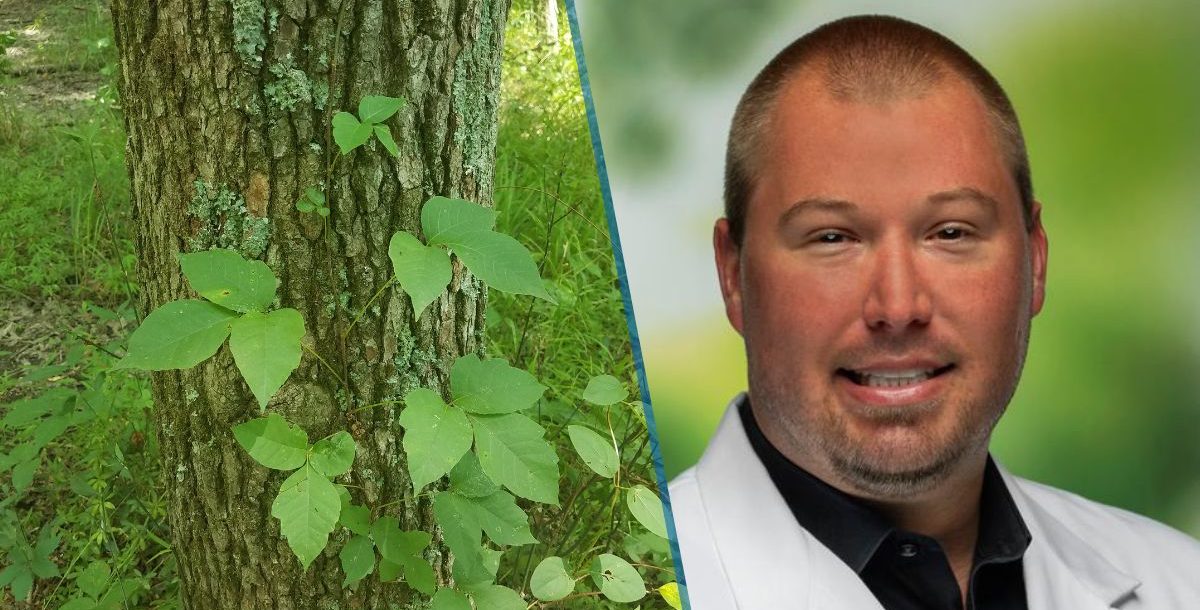If you spend lots of time outdoors in the summer, you may find yourself needing tips on poison ivy rash treatment.
Poison ivy has an oil inside called urushiol that causes an allergic reaction in most people. It shows up on your skin as an itchy rash in the places that touched the oil.
What does poison ivy look like?
Poison ivy grows as a shrub or a vine. Its leaves split into three sections, called leaflets, and these leaflets may contain white berries. In the summer, the leaves are bright green. They turn yellow or orange in the fall and red in the spring.
As the old saying goes, “Leaves of three, let it be.” This is a common way for people to remember how to identify poison ivy or poison oak so they can avoid touching it. However, a similar plant called poison sumac, which causes a similar reaction to poison ivy and oak, grows with leaves in clusters of seven to 13 and in pairs.
“It’s worthwhile to familiarize yourself with the appearance of these various plant species as identification and avoidance of toxic plants, and related allergens are key to prevent poison ivy dermatitis,” says Ryan Paulson, DO, a family medicine provider at Bon Secours – Paris View Family Practice in our Greenville market.
What does a poison ivy rash look like?
A poison ivy rash typically shows up within three days after you touch the oil. You may notice red patches on your skin with raised blisters. The rash can also appear in streaks where the plant’s stems moved across your limbs. Poison ivy, oak and sumac can all cause similar reactions.
“When you hear the term ‘poison ivy,’ commonly the first visual that comes to mind is an itchy rash on your exposed skin after being outdoors or venturing in the woods,” Dr. Paulson says. “That “rash” is actually an allergic contact dermatitis due to encountering a member of the Toxicodendron species.”
In addition to the rash, you may see swelling in the area. And if you are allergic to poison ivy, you may have a severe reaction that includes pus-filled blisters.
How long does a poison ivy rash last?
After a known exposure, patients should remove any contaminated clothing and wash their whole body with a mild soap or dish soap on a damp washcloth under very warm or hot running water as soon as possible. One study found that after about 10 minutes on the skin, 50 percent of the oils can be removed. This number falls to 10 percent after 30 minutes and 0 percent after one hour. If you can’t quickly access cleansers such as dishwashing liquid, plain water can be used to wipe the skin in the same fashion. This will at least remove some of the resin, Dr. Paulson says.
Even if you are able to wash some of the resin off, you may still develop a rash. While it typically appears within three days, a poison ivy rash can show up anywhere from four hours to 10 days after your skin comes in contact with the plant’s oil.
From there, the rash typically lasts two to three weeks. However, you may notice that your first poison ivy reaction can last longer than subsequent reactions. People who are allergic to the plant also may have a more long-term reaction than other people.
Complications are uncommon, Dr. Paulson says. However, if you do experience any, they can include postinflammatory hyperpigmentation, which is the darkening of the affected skin, or an even less common secondary bacterial infection.
Is a poison ivy rash contagious?
No, poison ivy is not contagious, nor does it spread. You can touch a poison ivy rash on someone without developing a rash. However, you may have a reaction if they left traces of the plant’s oil on clothing or another object.
Dogs don’t usually react to poison ivy, but they can pass it on to you if they have some of the oil on their fur. This is why it’s a good idea to wash your dog after it has been in the woods and to thoroughly clean all of your clothing and equipment that may have come in contact with the poison ivy plant.
What are some at-home poison ivy rash treatment options?
If you scratch your poison ivy rash or blisters, you can cause an infection through bacteria under your fingernails. You also may find it hard to relax or sleep with itchy skin.
For this reason, most treatments available for poison ivy aim to relieve the itching you feel.
You can try the following at home:
- Antihistamines, like diphenhydramine (Benadryl) or loratadine
- Bath soaks in cool water with baking soda or colloidal oatmeal
- Calamine lotion or menthol cream
- Cool compresses
- Cortisone cream or ointment
“Oatmeal baths and cool, wet compresses may be helpful to alleviate skin discomfort. Topical treatment with compounds containing menthol and phenol (calamine lotion) may also provide symptomatic relief,” Dr. Paulson says. “Sedating antihistamines given at bedtime may be beneficial for patients who itch at night. Sedating antihistamines may increase daytime sleepiness and should be used with caution, particularly in older adults.”
How we can help
In many cases, you can treat poison ivy at home as long as you know for sure that you came in contact with the plant. However, sometimes home remedies for poison ivy rash treatment are not enough. Reach out to your primary care provider if the itchiness does not go away or is interfering with your daily routine. They may be able to give you an oral steroid to relieve itching from a severe rash.
Learn about the primary care services we offer at Bon Secours.





